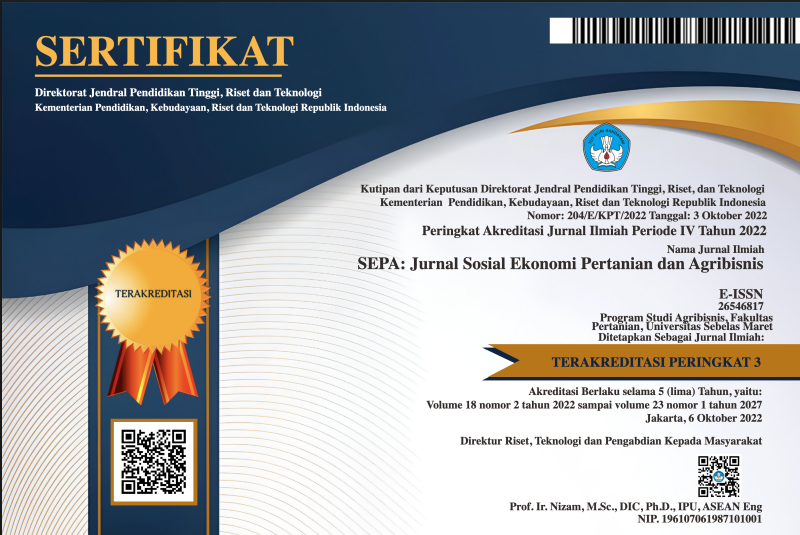THE EFFECT OF INSTITUTIONAL CONTEXT ON THE GOVERNANCE OF EMERGENT SUPPLY CHAINS: A CASE STUDY OF CASSAVA SECTOR IN VIETNAM
Abstract
This paper investigates how transactions between firms are organized in an emerging market and how supply network governance affects supply network outcomes and catching up with merging market firms. We explored firms’ choices of governance in a specific context of Vietnam, where a legal institution is characterized by a weak legal system for contractual enforcement and socio-economic institution is characterized by transition from central planning into the market mechanism. This study examines how firms in the cassava sector in Vietnam structure their transactions and how supply network governance relates to certain supply network outcomes. A comparative case study method was adopted in this research. Two cassava supply networks, of which one is traditional type and another is led by a foreign-invested firm, were selected for study. Our findings indicate that institutional context, supply chain structure, product characteristics, relationship investment influence firms’ choices of governance, and firms’ choices of governance affect supply chain network outcomes and local firms’ catching up. In the absence of legal enforcement, market governance is popularly applied in the supply chain with fragmented structure while relational governance is popular used in more concentrated supply network. Higher value creation and more possibilities for catching up but more inequality in income distribution in supply chain with large scale lead firm. Lower value creation, rare possibilities for catching up but more equality in income distribution in supply chain with fragmented small scale firms.
Keywords
Full Text:
PDFReferences
Andersen, P.H. and Christensen, P.R. 2005. Bridges over troubled water: suppliers as connective nodes in global supply networks. Journal of Business Research, Vol.58, No.9, 1261-73.
Bair, J. 2005. Global Capitalism and Commodity Chains: Looking Back, Going Forward, Competition and Change 9: 153-180.
Davis, L. E and North, D.C (1971) Institutional Change and American Economic Growth. Cambridge University Press
Gereffi, G., J. Humphrey, and T. Sturgeon (2005) The governance of global supply chains. Review of International Political Economy 12, No. 1: 78–104.
Granovetter, M (1985). Economic Action and Social Structure: The Problem of Embeddedness’, American Journal of Sociology, 91: 481–510.
Gulati, Ranjay (1995) Does Familiarity Breed Trust? The Implications of Repeated Ties for Contractual Choices in Alliances. Academy of Management Journal, 38:85-112.
Johnson, Simon; Kaufmann, Daniel andShleifer, Andrei. 1997. The Unofficial Economy in Transition. Brookings Papers on Economic Activity, 2, pp. 159-221.
Johnson, Simon and Loveman, Gary. 1995.Starting Over in Eastern Europe, Boston,
Harvard Business School Press,
Johnson, Simon; McMillan, John and Woodruff, Christopher.2002. Courts and Relational Contracts. Journal of Law, Economics, and Organization 18 (1), Spring, pp. 221-277.
Jones, C; HesterlyW. S and Borgatti,S. P.1997. A general theory of network governance: Exchange conditions and social mechanisms. Academy of Management Review 22/4:911–945.
Lorenz, E. 1988. Neither Friends nor Strangers: Informal Networks of Subcontracting in French Industry’, in D. Gambetta (ed.), Trust – Making and Breaking Cooperative Relations, Oxford: Basil Blackwell.
McMillan, John. 1997. Markets in Transition. Advances in Economics and Econometrics:
Theory and Applications, ed. David M. Kreps and Kenneth Wallis, Cambridge: Cambridge University Press.
McMillan, J., Woodruff, C., 1999. Dispute Prevention Without Courts in Vietnam. Journal of Law Economics and Organization 15 (3), 637–658.
McMillan, J. and Woodruff, C.2002. The central role of entrepreneurs in transition economies. Journal of Economic Perspectives 16(3): 153-170.
Ministry of Justice of Vietnam.2013. Institutional improvement and legal reform in Vietnam.
http://moj.gov.vn/en/ct/Lists/TalkingLaws/View_Detail.aspx?ItemID=108
North, D. 1990. Institutions, Institutional Change and Economic Performance. Cambridge: Cambridge University Press.
Patton, M. 1990. Qualitative evaluation and research methods. 2nd ed.Sage.
Peterson, H.C., Wysocki, A. and Harsh, S.B. 2001. Strategic choice along the vertical coordination continuum. International Food and Agribusiness Management Review,Vol. 4: 149-66.
Pilbeam, Colin; Alvarez, Gabriela and Wilson, Hugh. (2012),"The governance of supply networks: a systematic literature review", Supply Chain Management: An International Journal, Vol. 17 Iss: 4 pp. 358 - 376
Tesco.com (2015) http://www.tesco.com/groceries/product/details/?id=264388430
Bloomberg.com (2015) http://www.bloomberg.com/news/articles/2015-02-11/catfish-king-ready-to-hook-exports-on-free-trade-deals.
Thorelli, H .1986. Network between Market and Hierarchy, Strategic Management Journal, Vol 7, No1, pp:37-51
Tran, T.B; Grafton, R.Q & Kompas, T. 2009.Institutions matter: The case of Vietnam. The Journal of Socio-Economics, 38(1): 1-12
Trochim, W. M.K .1989. Outcome pattern matching and program theory. Evaluation and Program Planning, Vol. 12, pp. 355-366
Williamson, O.E. 1975. Markets and hierarchies. Free Press, New York.
Williamson, O.E. 1979. Transaction-cost economics: The governance of contractual relations, Journal of Law and Economics, Vol 22, 233-261.
Williamson, O.E .1996. The mechanisms of Governance.NY: Oxford U. Press.
Yin, R. K. 2009. Case study research: Design and methods. Sage Publications
DOI: https://doi.org/10.20961/sepa.v16i2.35718
Refbacks
- There are currently no refbacks.



.png)







.png)
3.png)





